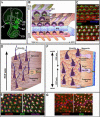Line up and listen: Planar cell polarity regulation in the mammalian inner ear
- PMID: 19508855
- PMCID: PMC2796270
- DOI: 10.1016/j.semcdb.2009.02.007
Line up and listen: Planar cell polarity regulation in the mammalian inner ear
Abstract
The inner ear sensory organs possess extraordinary structural features necessary to conduct mechanosensory transduction for hearing and balance. Their structural beauty has fascinated scientists since the dawn of modern science and ensured a rigorous pursuit of the understanding of mechanotransduction. Sensory cells of the inner ear display unique structural features that underlie their mechanosensitivity and resolution, and represent perhaps the most distinctive form of a type of cellular polarity, known as planar cell polarity (PCP). Until recently, however, it was not known how the precise PCP of the inner ear sensory organs was achieved during development. Here, we review the PCP of the inner ear and recent advances in the quest for an understanding of its formation.
Figures



References
-
- Gubb D, Garcia-Bellido A. A genetic analysis of the determination of cuticular polarity during development in Drosophila melanogaster. J Embryol Exp Morphol. 1982;68:37–57. - PubMed
-
- Keller RE, Danilchik M, Gimlich R, Shih J. The function and mechanism of convergent extension during gastrulation of Xenopus laevis. J Embryol Exp Morphol. 1985;89(Suppl):185–209. - PubMed
-
- Keller R, Tibbetts P. Mediolateral cell intercalation in the dorsal, axial mesoderm of Xenopus laevis. Dev Biol. 1989;131:539–49. - PubMed
-
- Wallingford JB, Rowning BA, Vogeli KM, Rothbacher U, Fraser SE, Harland RM. Dishevelled controls cell polarity during Xenopus gastrulation. Nature. 2000;405:81–5. - PubMed
-
- Klein TJ, Mlodzik M. Planar cell polarization: an emerging model points in the right direction. Annu Rev Cell Dev Biol. 2005;21:155–76. - PubMed
Publication types
MeSH terms
Grants and funding
LinkOut - more resources
Full Text Sources

